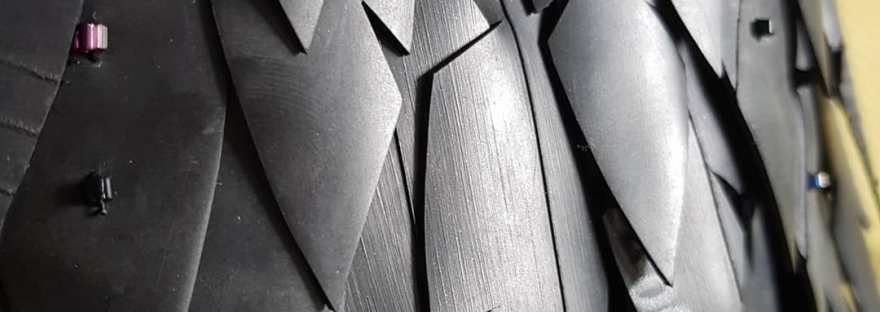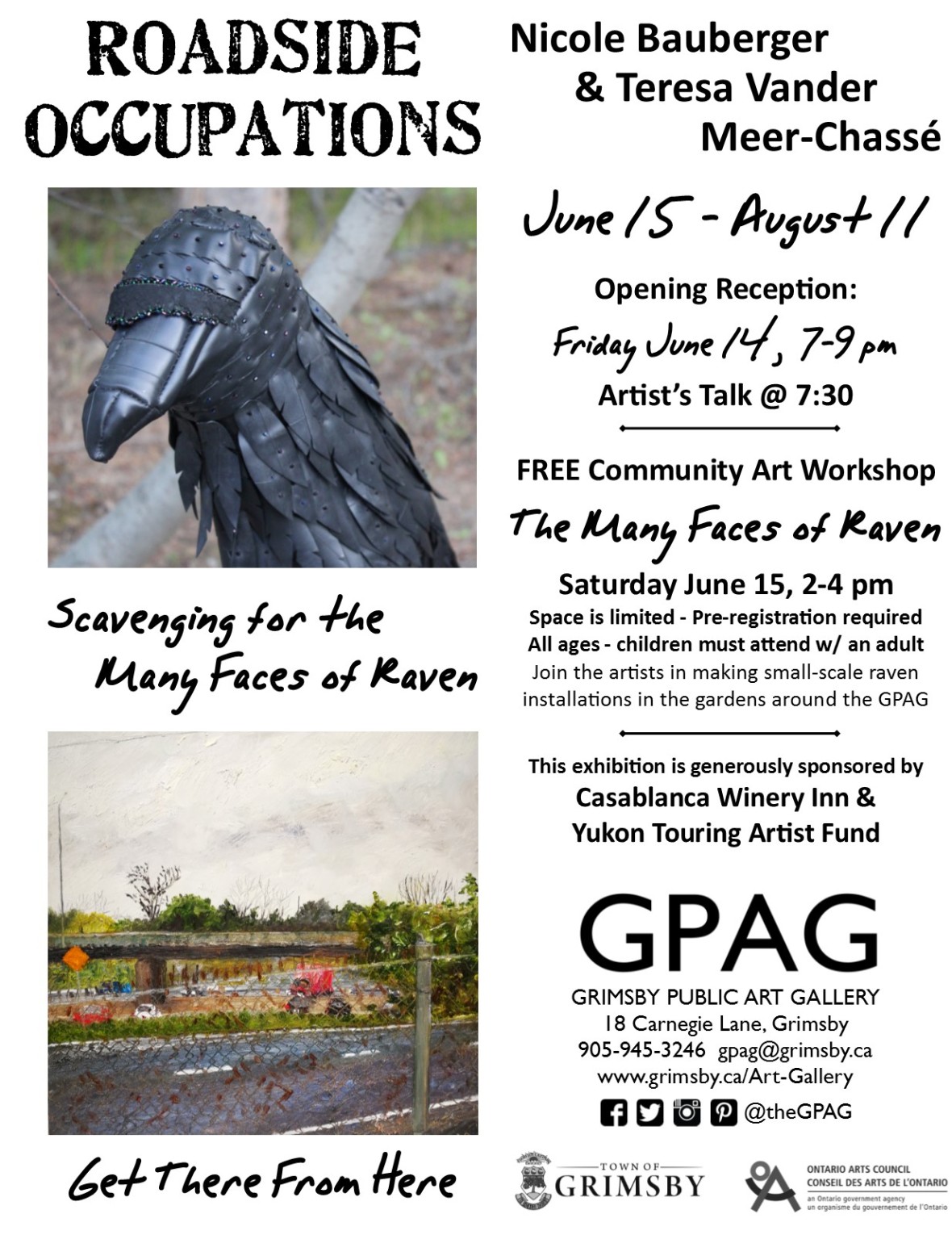
Yukon Artists @ Work
On Friday, October 5th Nicole and Teresa hosted the opening reception of Scavenging for the Many Faces of Raven at Yukon Artists @ Work Gallery (4th Ave & Wood St) in Whitehorse, Yukon. The exhibition will be up until October 28th.
The artists would like to thank the Canada Council for the Arts and the Yukon Advanced Artists Award for their support in the earlier development of the work for this show. They would also like to thank everyone who hosted a Scavenging for the Many Faces of Raven installation in their front yards.
Nicole would like to thank fellow YA@W members Sandra Grace Storey and Jeanine Baker. Sandra fired the clay pieces and helped Nicole figure out oxides and so on. Jeanine showed Nicole how to use the tools she’s using to cold work found glass.
Teresa would like to thank her mother, uncle, and father for assisting with the completion of some of the works. Teresa would also like to thank everyone that provide ongoing support and encouragement throughout this project.
Scavengers Hunt for Raven
Culture Days is just around the corner! Download the map here: click here
How to view the Ravens
(1) 35 Tamarack Dr. – Interact with the Ravens in the front yard.
(2) Yukon Arts Centre, 300 College Dr. – Follow the interactive Ravens to the path into Doug Smarch Jr’s Forest Walk to discover the installation of flying Ravens. Also look in the garden near the Arts Centre and at the bluffs side of the outdoor amphitheatre.
(3) 36 Dieppe Dr. – Look at the front of the freestanding garage for this installation. You can also spot a mural by Joseph Tisiga on the garage’s side wall to the right.
(4) Lumel Studios, 101 Keish St. – These glass-embellished Ravens perch and fly on the old Land Rover in the garden.
(5) Cadence Cycle, 508 Wood St. – Find the Raven in the bike wheel outside. Might be located at 506 Wood later in the month.
(6) Yukon Artists @ Work Gallery, 4th and Wood St. – You can go into the yard to play with this interactive sculpture. Try to balance the Ravens using washers. Oct. 5-18, also see our exhibit inside.
(7) 409 Hawkins St. – Please view works outside fence.
(8) 31 Teslin Rd. – View a large Raven sculpture in the tree but can you spot the tiny Ravens along the hedge?
(9) 126 Alsek Rd. – These Ravens are enjoying the trees and can be easily viewed from the roadside.
(10) 7 Wilson Dr. – Please view these playful Ravens from the roadside.
(11) 57 Kluane Cres. – Pay close attention as these Ravens will be along the roadside. Park carefully as the road is narrow.
(12) 151 Dalton Trail – Park to the right of the duplex and walk along the trail behind this address. You can spot two flying Ravens near the shed.
(13) Yukon Transportation Museum, 30 Electra Cres. – Find the Ravens in the locomotive, in the entrance awning, and woven into the chain link fence outdoors.
(14) Bordertown Garage and Museum – Ask at the Beaver Creek Visitor Information Centre for Sid.
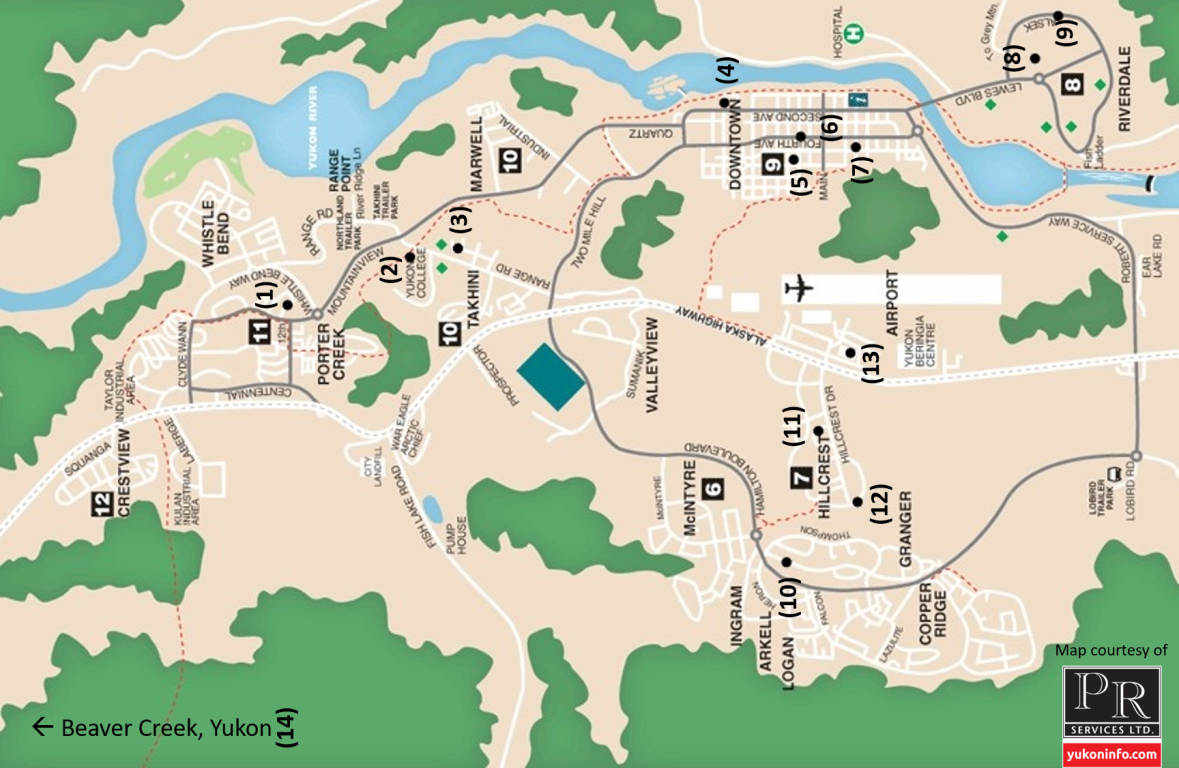
Adventures in the East
Nicole and I had the wonderful opportunity of travelling to Ottawa, Ontario and Montreal, Quebec at the end of May 2018 to host a workshop with McGill University’s Art Hive. I had never been to Ottawa before but was excited to visit the Ottawa Art Gallery and the Art Gallery of Canada.
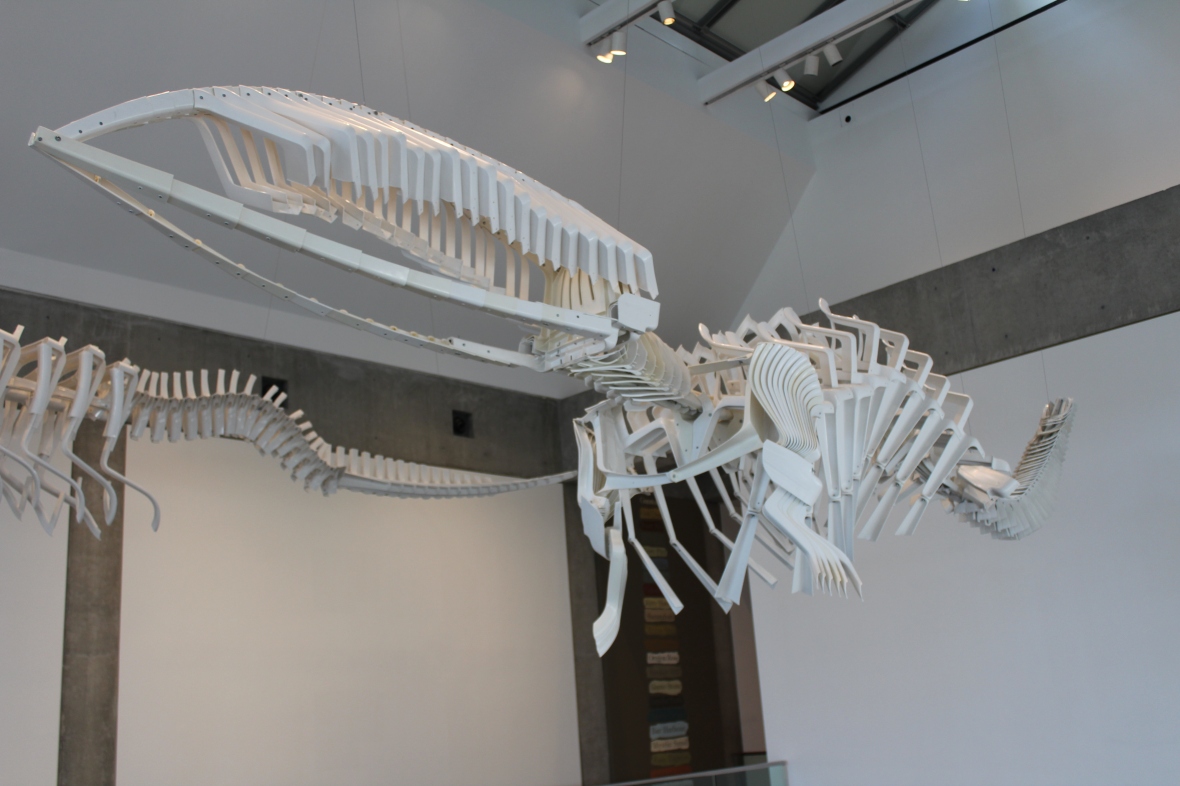
Brian Jungen, Art Gallery of Canada
The Ottawa Art Gallery had been recently renovated and included land acknowledgements and Indigenous languages. The Art Gallery of Canada, however, did not live up to its name, in my eyes. There are only two Yukon artists in the Art Gallery of Canada’s Collection – Joseph Tisiga and Doug Smarch Jr. Neither of these artists’ work was exhibited at the time when we went to visit the site. 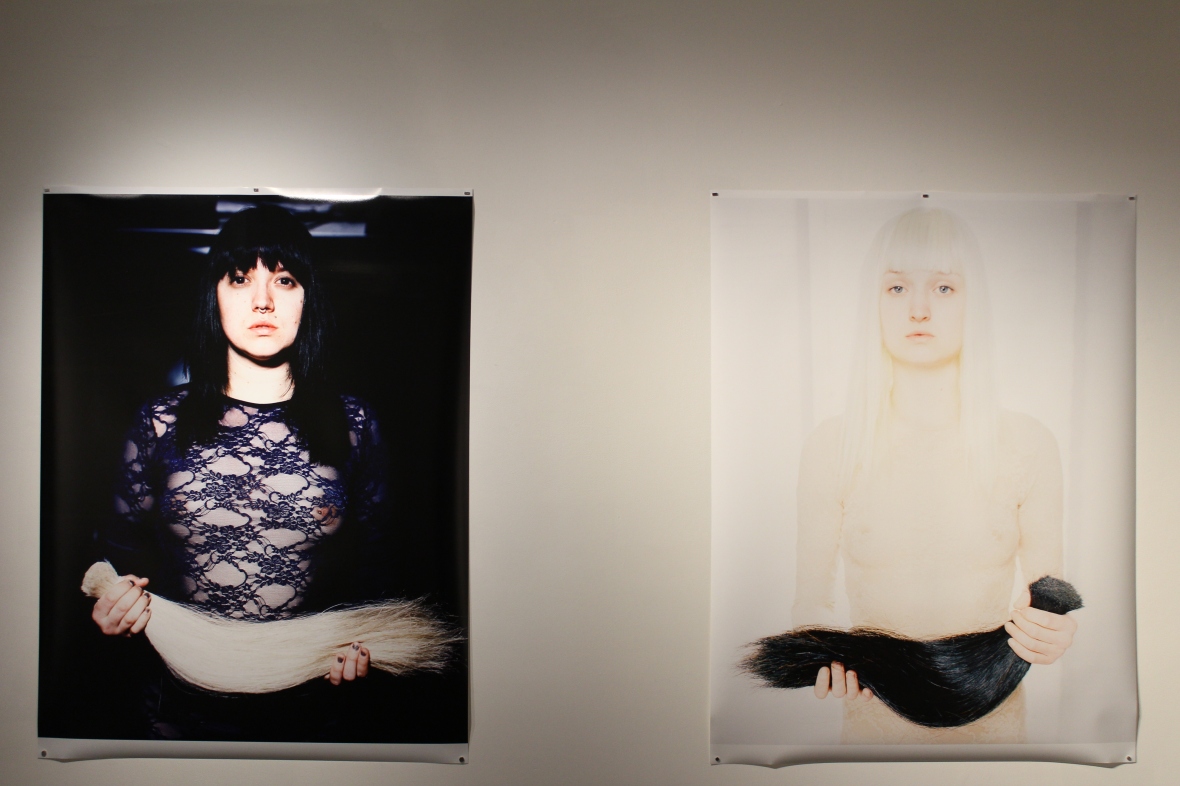
Dayna Danger, Art Mur
We arrived in Montreal just in time to witness the Indigenous art biennial that focused Indigenous women artists. A truly exceptional experience and one to remember. Many of these artists I had heard of but have not had the pleasure of viewing their work. Montreal is one of the hubs of Indigenous art in Canada. We were also lucky enough to be in the city the first day when Here We Are Here: Black Canadian Contemporary Art was on exhibition at Musee des beaux-arts.
Our workshop at McGill University was well attended by students within the education department. We did a brief artist talk to situate the students into the importance of this project. We received excellent feedback on the workshop and, I believe, the students walked away with new found knowledge.
Sculpting Raven’s Head
One of the things that Teresa and I have found along the way, is that a representational and recognizable raven’s head helps animate the raven-like abstract energies of the found tires. We found this in the installation at her Grandpa’s museum in Beaver Creek that you previously read: 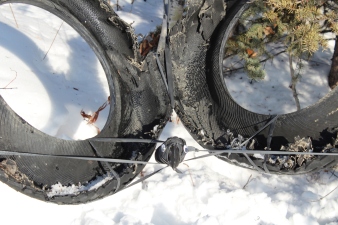
This head was a rather ad-hoc
construction of styrofoam, bike tubes, and googley eyes. I hesitated to leave it there, knowing it was likely not tough enough to withstand weather. I hear it’s a little tattered now.
I have also created raven’s heads in porcelain, blacked with oxides, much more suited to long-term outdoor installation. I look forward to seeing how Teresa and I use them when I get them back from firing.
In the meantime I have also used air-dry clay, blackened a little further with acrylic paint, to make interior-grade raven’s heads. They make for interesting two-part tabletop sculptures with tire fragments:
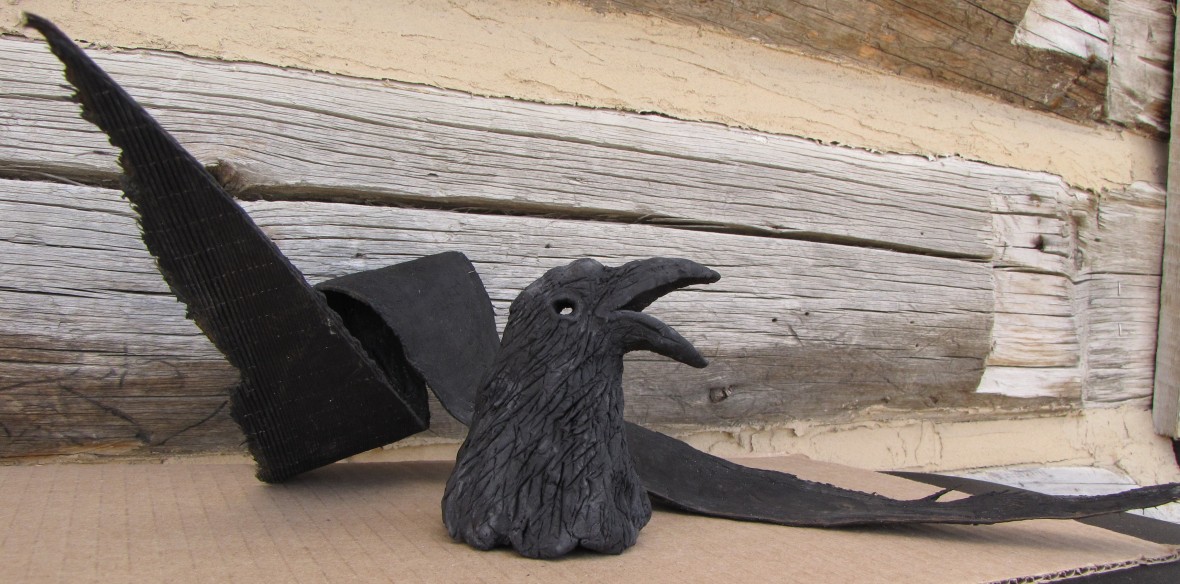
And there’s one that works pretty well with a piece of tattered styrofoam meat tray that I found while walking across the puddles to the Jenni House:
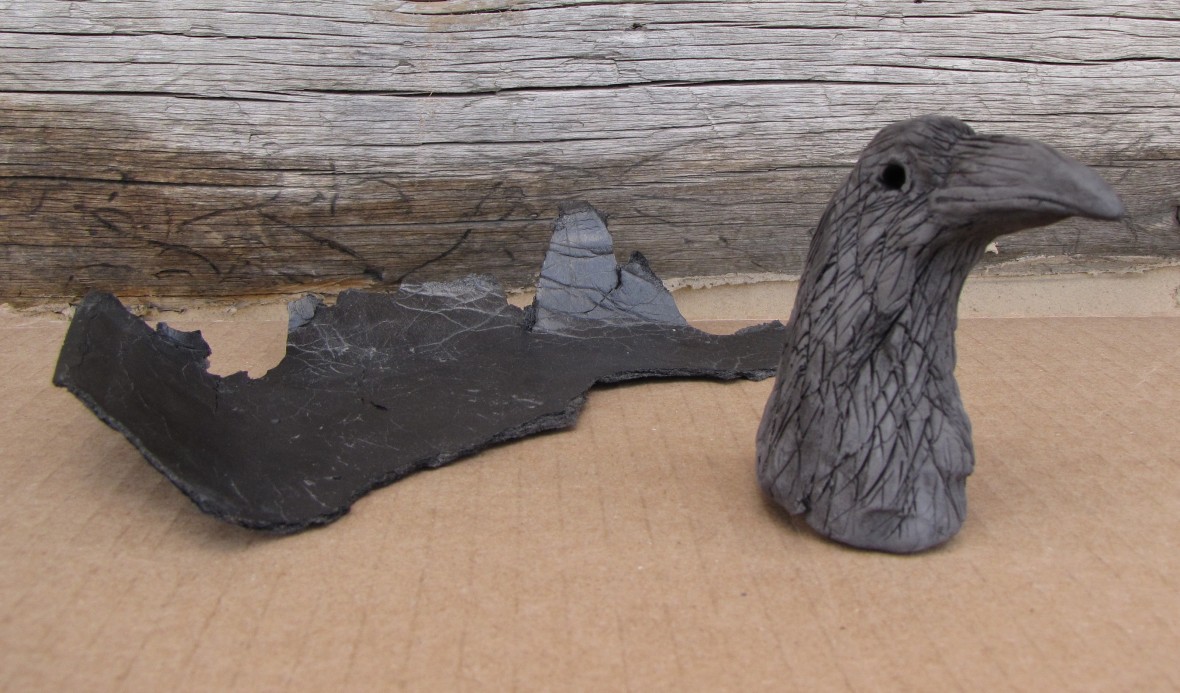
While we looked at these, Teresa suggested mounting them to the flat detatched pieces of tire tread, on the wall. I realized I would have to change the angle of the head for this to work. I had some hesitation, fearing that it would be kind of like a taxidermied ‘trophy mount,’ which I wasn’t totally comfortable with. But I tried it anyway, and liked the sense of power, and of coming up out of the wall, that the raven seemed to convey this way. After experimenting with ways to sewing the pieces together, I arrived at a way that leaves the sinew visible. The two ends of sinew below the piece remind me of raven legs, hanging down while taking off or landing.
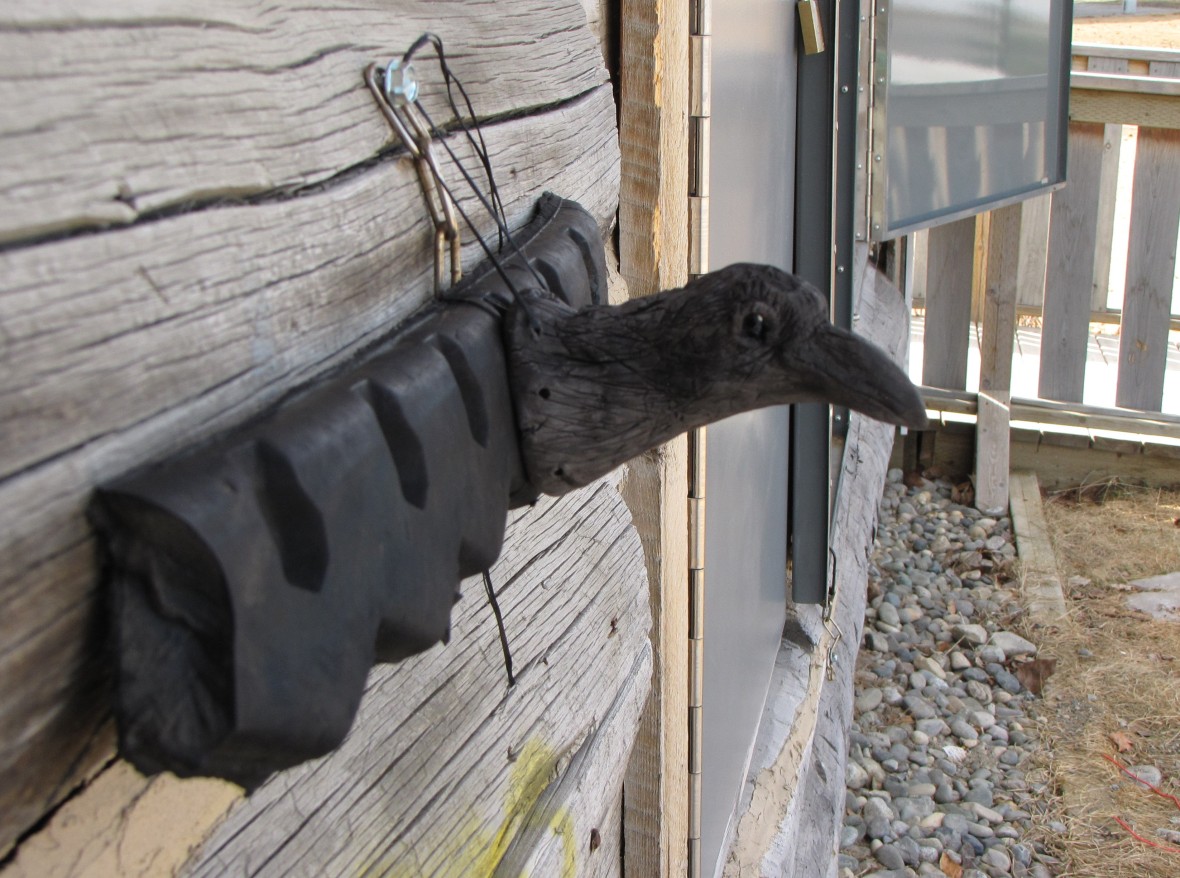
Raven Adventures in Beaver Creek
I come from the small bordertown community of Beaver Creek, Yukon. It was important to us that this project focus on the stretch of highway connecting Whitehorse to Beaver Creek. We ensured community engagement by offering workshops to schools in Haines Junction, Destruction Bay, and Beaver Creek. Despite it being the last day before their spring break, the children were amazingly creative!
In Beaver Creek we were invited to join the school at their annual muskrat camp held at Swan Lake, between the Canadian and US borders. For those that are not aware of what a muskrat is, it is a small creature that oddly resembles a beaver and has a rat-like tail. They often occupy frozen lakes during the winter months.
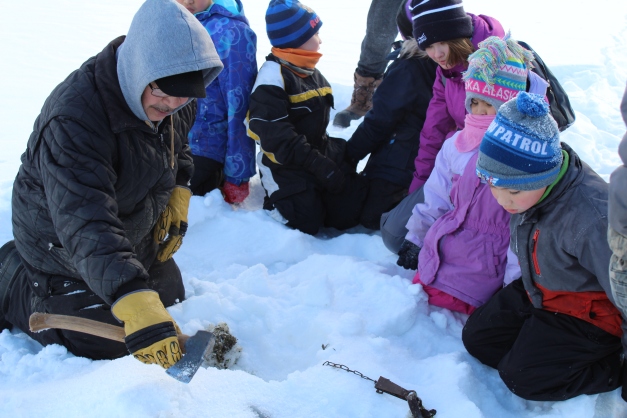 Nicole and I were able to witness two muskrats caught and Nicole was lucky enough to have a taste!
Nicole and I were able to witness two muskrats caught and Nicole was lucky enough to have a taste!
Later that afternoon, I took Nicole to the Beaver Creek dump (landfill) to see if we could find any tires. The tires were buried beneath the snow and we were unable to access them, however, we came across something even more interesting – Raven tracks.
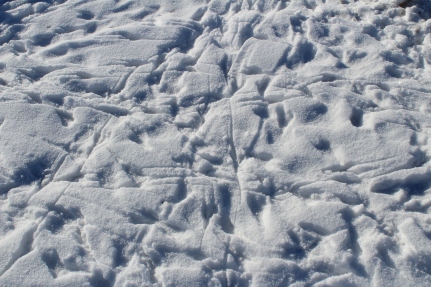 The Ravens at the Beaver Creek dump created thousands of little footprints in the snow as well as the beautiful markings they create with their wings, like a child making snow angels.
The Ravens at the Beaver Creek dump created thousands of little footprints in the snow as well as the beautiful markings they create with their wings, like a child making snow angels.
Although we were unable to find any useful tires at the dump, Carl from Far West, aka Mr. Yukon, was able to provide us with tires. While lifting the tires into the car, Nicole had the idea that the split tires conceptually resembled the wings of a Raven. We wanted to test this theory by installing the tire outside in the trees, what better place to display this type of work than my Grandpa Sid’s Bordertown Garage and Museum!
We stretched and pulled the tire and tied it to the surrounding trees by way of tire tubes and Nicole added a cute Raven head for an extra touch. Ask for Sid at the Visitor Information Centre to view this installation in Beaver Creek, Yukon and visit http://www.facebook.com/bordertowngarageandmuseum for an update on this piece. 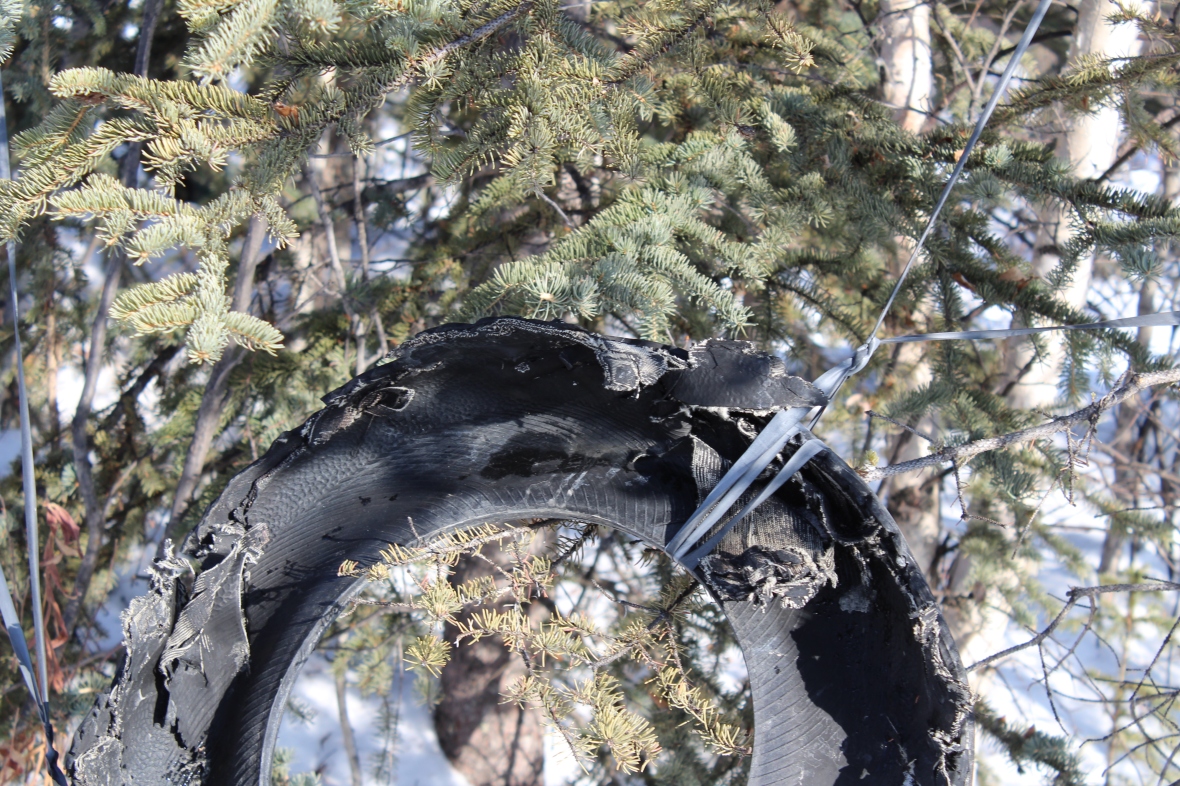
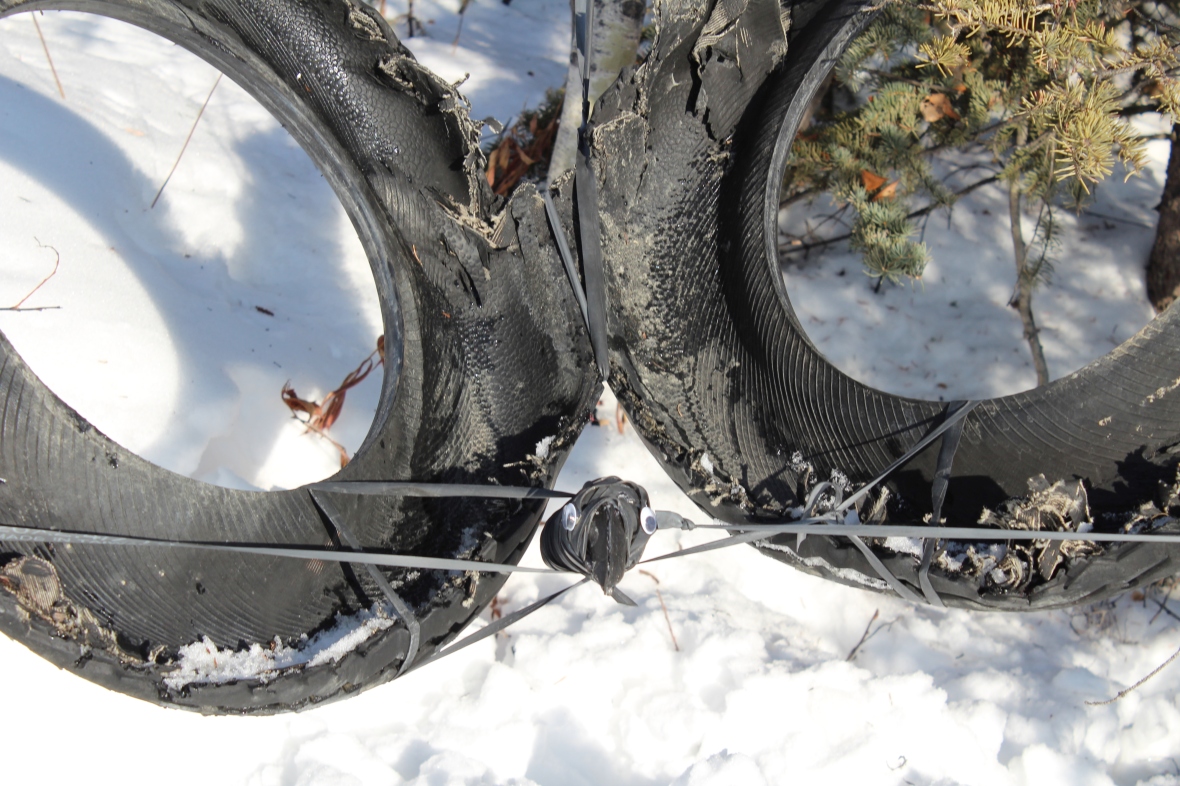
Feather Dress
In addition to the raven, I use the dress as a motif in my artwork. It’s a form I use to explore variations, like a motif is used in music. I could write for awhile about its layers of meanings, but let’s just call it a sculptural form for now…
I wanted to try to make a dress out of these tire fragments.
Teresa kindly agreed to act as a model for the dress. I built a dress form on her using zippy wrap and clear packing tape. (See here for other applications of this technique.)
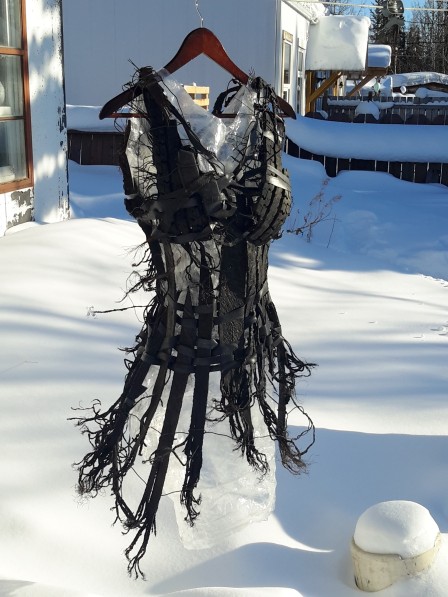 I stuffed the form with paper, then started trying to attach pieces of tire. Pins bent and let go. Then I wrapped the form in a strip cut from a discarded bike tire tube, and wove the tire fragments into that.
I stuffed the form with paper, then started trying to attach pieces of tire. Pins bent and let go. Then I wrapped the form in a strip cut from a discarded bike tire tube, and wove the tire fragments into that.
I wove a bit more bike tube into the form, and added heavy black baling wire, the kind you might use to wire your exhaust system up so it doesn’t drag on the ground.
When I unstuffed the dress, I found I liked the plastic dress form inside it. The way it caught the light seemed to complement the tire fragments. I may cut the bottom into a fringe.
The dress’ weight threatened to collapse the form a bit, so I added some cross-pieces of coroplast inside. This is where we’ve gotten to so far. It seems like a good way to try this tire-fragment material on, so to speak.
Creating Raven
In January 2018, I moved to Squamish, BC for a couple months to work as a full-time artist and begin to develop the collaborative project. Nicole had begun creating a dress-form with tires so I decided I would try my hands at creating a small Raven from found tires and bicycle tire tubes.
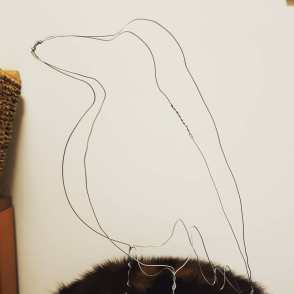 In early February I began to create the piece. My mom came to visit and helped me start the wire form. I’ve never done sculpture before so it was an entirely new experience. After creating the wire form I then added stuffing, similar to the material you would put in a Teddy Bear. I then duct-taped the entire piece. The beak did not hold its shape so I had to remake the beak from a toilet paper role and electrical tape.
In early February I began to create the piece. My mom came to visit and helped me start the wire form. I’ve never done sculpture before so it was an entirely new experience. After creating the wire form I then added stuffing, similar to the material you would put in a Teddy Bear. I then duct-taped the entire piece. The beak did not hold its shape so I had to remake the beak from a toilet paper role and electrical tape.
At the same time of taping, I also began to cut out feathers from tire tubes I received from Corsa Cycles, a local bike shop in Squamish, BC. I cut several tubes into strips and sewed the feathers on. I also beaded some of the feathers with purple, blue, and black delica beads. After the bird was fully taped I wrapped the tube stripes around the body and sewed it all together. I then worked on sewing the beak together which is my favorite part of the bird.

I soon noticed the Raven was top heavy so I added shredded bits of car tires to the tail to weigh out the upper portion of the sculpture. With the added weight, the feet, that were still only tape, would not hold the body. I made a hole in the bottom of the feet and pushed chop sticks through the entire body to make sure it was sturdy.
The piece is not yet done, I still have a bit more sewing to do as well as finishing the feet and creating a stand where it can rest.
Flying Tire Ravens
The thing about these shattered tires is, they look like ravens already. Some parts look like feet, ready-made. Other parts look like wings. 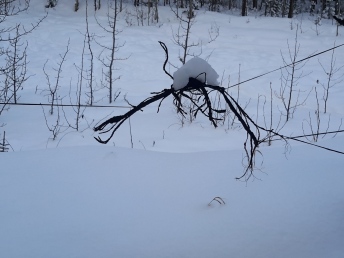
I (Nicole) was looking at the shapes of some of the pieces and they seemed like they were already very close to the shape of flying ravens.
So I took them out to my backyard and using imitation sinew strung them between my wall tent and some trees.
That was good. And they’re also durable – being installed outdoors for months seems to cause them no bother whatsoever.
Even with their burden of snow, collected in the most recent snowfall, they still express a sense of raven to me.
Feeling Inspired
In August 2017, Nicole Bauberger attended an artist talk by Teresa Vander Meer-Chasse, on her first solo show, Rez Car, which consisted of beaded and quilled roadside found hubcaps. Nicole and Teresa struck up a conversation involving the fragments of blown tires on the side of the Alaska Highway and how they oddly reminded the two of Ravens. This quickly led to an idea of collaboration and a proposal to Canada Council.
With a creative project and successful application, Nicole and Teresa have begun work on this project, inspired by stories and art. They will be working collectively from now until the end of May to create an exhibition of Raven and raven-inspired sculptural works from tire remnants found alongside (primarily) the Alaska Highway, from Whitehorse to Beaver Creek, Yukon.
Wanting to ensure community participation, Nicole and Teresa will be visiting select communities to host workshops involving storytelling, sharing experiences involving Raven, and creating art inspired by Raven. Public workshops, as well as, school workshops are now being organized. Check the “Event” page for more information. Contact us on how you can get involved.






